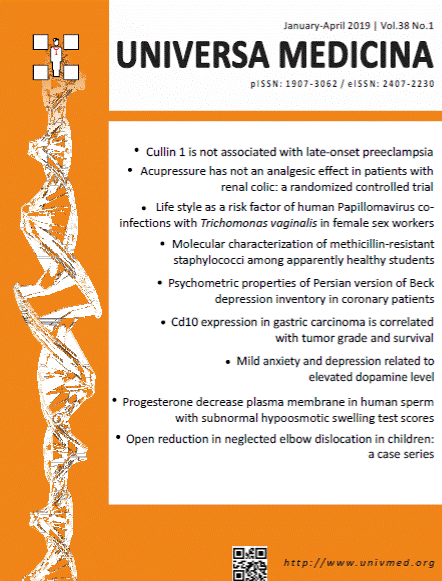Molecular characterization of methicillin-resistant staphylococci among apparently healthy students
Main Article Content
Abstract
Staphylococcus aureus are widely considered a major factor of nosocomial and community-acquired infections. This work was aimed at determining the prevalence of methicillin-resistant S. aureus (MRSA) among apparently healthy students.
Methods
A cross-sectional study was conducted involving 400 nasal swab samples randomly collected from students using sterile swab sticks and processed to recover S. aureus using standard microbiological techniques. Conventional methods were used to identify the isolates and antibiotic susceptibility tests were performed using Kirby-Bauer disc diffusion method according to performance standards of Clinical and Laboratory Standard Institute guidelines. Methicillin-resistance was detected phenotypically using cefoxitin 30µg discs. Bacterial deoxyribonucleic acid (DNA) extraction was done on cefoxitin-resistant staphylococci isolates only using ZymoResearch (ZR) fungal/bacterial DNA MiniPrepTM kit. A polymerase chain reaction assay targeting the 16S rRNA, nuc, and mecA genes on 1.0% agarose gel electrophoresis stained with ethidium bromide was used to identify S.aureus and detect methicillin resistance.
Results
The overall prevalence of MRSA was 5.8% using phenotypic methods. PCR amplification of the 23 phenotypically confirmed MRSA using 16S rRNA and nuc genes identified staphylococci 23/23(100%) and S. aureus 23/23(100%) at band size 886bp and 225bp respectively. However, 16(69.6%) were positive for mecA gene at band size 532bp by PCR method. Poor level of susceptibility was recorded among the MRSA namely to erythromycin (26.6%), cloxacillin (0%), augmentin (0%), cefuroxime (0%), ceftriaxone (0%) and ceftazidime (0%). Ofloxacin was the most effective antibiotic (60.9%).
Conclusion
Active antimicrobial surveillance of pathogenic staphylococci is important to analyze the infections and transmission rate for possible control measures.
Article Details
Issue
Section

This work is licensed under a Creative Commons Attribution-NonCommercial-ShareAlike 4.0 International License.
The journal allows the authors to hold the copyright without restrictions and allow the authors to retain publishing rights without restrictions.
How to Cite
References
Peng Q, Hou B, Zhou S, et al. Staphylococcal cassette chromosome mec (SCCmec) analysis and antimicrobial susceptibility profiles of methicillin-resistant Staphylococcus aureus (MRSA) isolates in a teaching hospital, Shontou, China. Afr J Microbiol 2010; 4: 844-8.
Rongpharpi SR, Hazarika NK, Kalita H. The prevalence of nasal carriage of Staphylococcus aureus among healthcare workers at a tertiary care hospital in Assam with special reference to MRSA. J Clin Diagn Res 2013;7:257–60. doi: 10.7860/JCDR/2013/4320.2741.
Garza-González E, Morfin-Otero R, Llaca-Diaz JM, et al. Staphylococcal cassette chromosome (SCCmec) in methicillin-resistant coagulase negative staphylococci. A review and the experience in a tertiary-care setting. Epidemiol Infect 2010;138:645–54. DOI: https://doi.org/10.1017/S0950268809991361
Treesirichod A, Hantagoo S, Prommalikit O. Nasal carriage and antimicrobial susceptibility of Staphylococcus aureus among medical students at the HRH Princess Maha Chakri Sirindhorn Medical Center, Thailand: a follow-up study. J Infect Public Health 2014;7:205-9. doi: 10.1016/j.jiph.2012.12.004.
Olowe OA, Kukoyi OO, Taiwo SS, et al. Phenotypic and molecular characteristics of methicillin-resistant Staphylococcus aureus isolates from Ekiti state, Nigeria. Infect Dr Resist 2013;6:87–92. DOI: http://dx.doi.org/10.2147/IDR.S48809
Nwankwo BOK, Sale A, Magagi A, et al. Methicillin-resistant Staphylococcus aureus and their antibiotic susceptibility pattern in Kano, Nigeria. Afr J Clini Exper Microbiol 2010;11:1595–689. DOI: http://dx.doi.org/10.4314/ajcem.v11i1.44088.
Onemu OS, Ophori EA. Prevalence of multi-drug resistant Staphylococcus aureus in clinical specimens obtained from patients attending the university of Benin teaching hospital, Benin City, Nigeria. J Nat Sci Res 2013;5:154-9.
Shittu AO, Usman H, Adamu N, et al. Epidemiology and antibiotic susceptibility pattern of methicillin-resistant Staphylococcus aureus recovered from tertiary hospitals in North-eastern, Nigeria. J Med Medic Sci 2013;4:214-20.
Ibadin EE, Enabulele IO, Muinah F. Prevalence of mecA gene among staphylococci from clinical samples of a tertiary hospital in Benin City, Nigeria. Afr Health Sci 2017;17:100-10. https://dx.doi.org/10.4314/ahs.v17i4.7.
Okwu M, Bamgbala S, Aborisade W. Prevalence of nasal carriage of community-associated methicillin resistant Staphylococcus aureus (CA-MRSA) among healthy primary school children in Okada, Nigeria. J Natur Sci Res 2012;2:61-5.
Eke S, Abdulkadiri S, Okoro CJ, et al. The prevalence and resistivity pattern of Staphylococcus aureus isolates from apparently healthy university students in Ekpoma, Edo State, Nigeria. Inter J Bas Appl Innov Res 2012;1:183-7.
Ayepola, OO, Taiwo OS, Anifowose A, et al. Nasal carriage of Staphylococcus aureus and associated risk factors among students in a Nigerian University. Acta Sci Microbiol 2018;1:6-8. doi: 10.31080/ASMI.2018.01.0010.
Ayeni FA, Odumosu BT. False identification of other microorganisms as Staphylococcus aureus in Southern Nigeria. Trop J Pharm Res 2016;15:1941-5. http://dx.doi.org/10.4314/tjpr.v15i9.19
Liu Y, Zhang J, Ji Y. PCR-based PCR-based approaches for the detection of clinical methicillin-resistant Staphylococcus aureus. Open Microbiol J 2016;10:45-56. doi:10.2174/1874285801610010045.
Clinical and Laboratory Standards Institute. Performance standards for antimicrobial susceptibility testing approved standard M100-S23. Clinical and Laboratory Standards Institute, Wayne, PA;2013.
Biswajit B, Shibendu B, Bappa M. Isolation of imipenem resistant Staphylococcus aureus from post-operation pus sample in oral and maxillofacial infections. Res J Pharm Bio Chem Sci 2012;3:896-900.
Andrews JM. BSAC standardized disc susceptibility testing method (version 8). J Antimicrob Chemother 2009;64:454-89.
Kaya EG, Karakoc E, Yagci S, et al. Evaluation of phenotypic and genotypic methods for detection of methicillin resistance in Staphylococcus aureus. Afr J Microbiol Res 2009; 3:925-9.
Mahde SA, Reem QM, Nawfal RH. Nasal carriage rates of Staphylococcus aureus and CA-methicillin resistant Staphylococcus aureus among university students. J Microbiol Res 2015;5:123-7. doi:10.5923/j.microbiology.20150504.01
Bettin A, Causil C, Reyes N. Molecular identification and antimicrobial susceptibility of Staphylococcus aureus nasal isolates from medical students in Cartagena, Colombia. Brazil J Infect Dis 2012;16:329–34. doi: 10.1016/j.bjid.2012.06.017.
Kitti T, Boonyonying K, Sitthisak S. Prevalence of methicillin-resistance Staphylococcus aureus among university students in Thailand. Southeast Asian J Trop Med Pub Hea 2011;42:1498-504.
Zakai SA. Prevalence of methicillin-resistant Staphylococcus aureus nasal colonization among medical students in Jeddah, Saudi Arabia. Saud Med J 2015;36:807-12. https://doi.org/10.15537/smj.2015.7.11609.
Degaim ZD, Shani WS, Hamim SS. In Virulence factors of Methicillin Resistant Staphylococcus aureus (MRSA) isolated from burn patients. Inter J Curr Microbiol Appl Sci 2015;4:898-906.
Makgotlho PE, Kock MM, Hoosen A, et al. Molecular identification and genotyping of MRSA isolates. FEMS Immun Med Microbiol 2009;57:104–15.
Vremera T, Iancu LS, Logigan C, et al. Optimization of triplex real time PCR for detecting Staphylococcus aureus mecA, pvl and nuc genes. Roman Arch Microbiol Immun 2011;70:69–73.


